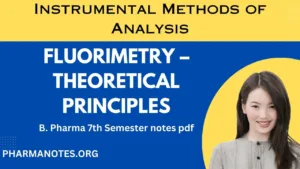Fluorimetry –Theoretical principles

Objectives
At the end of the session, the student will be able to
• Identify Fluorescence as an important phenomenon for the determination of many pharmaceutical substances
• Discuss the phenomenon of photoluminescence
• Explain the factors affecting Fluorescence
• Discuss the methods used for converting non-fluorescent substances to fluorescent
Fluorimetry
• Luminescence is the emission of light by a substance. It occurs when an electron returns to the electronic ground state from an excited state and loses its excess energy as a photon.
It is of 2 types.
• Fluorescence
• Phosphorescence
Ø Chemiluminescence
Flourescence:
• When a beam of light is incident on certain substances they emit visible light or radiations. This is known as fluorescence.
• Fluorescence starts immediately after the absorption of light and stops as soon as the incident light is cut off.
• The substances showing this phenomenon are known as flourescent substances.
Phosphorescence:
• When light radiation is incident on certain substances they emit light continuously even after the incident light is cut off.
• This type of delayed fluorescence is called phosphorescence.
• Substances showing phosphorescence are phosphorescent substances.
Theory of fluorescence and phosphorescence
• A molecular electronic state in which all of the electrons are paired is called singlet state.
• In a singlet state molecules are diamagnetic.
• Most of the molecules in their ground state are paired.
• When such a molecule absorbs uv/visible radiation, one or more of the paired electrons raised to an excited singlet state /excited triplet state.
From the excited singlet state one of the following phenomenon occurs:
• Fluorescence
• Phosphorescence
• Radiation-less processes
• Vibration relaxation
• Internal conversion
• External conversion
• Intersystem crossing
Jablonski energy diagram:
FLUORESCENCE AND CHEMICAL STRUCTURE:
• Fluorescence is most commonly observed in compounds containing aromatic functional groups with low energy.
• Most un-substituted aromatic hydrocarbons show fluorescence – quantum efficiency increases with the number of rings and degree of condensation.
• Simple heterocyclic do not exhibit fluorescence.
• The n – π*singlet quickly converts to the n – π* triplet and prevents fluorescence.
• Fusion of heterocyclic nucleus to
benzene ring increases fluorescence.
• Substitution on the benzene ring shifts wavelength of absorbance maxima and corresponding changes in fluorescence peaks
• Fluorescence decreases with increasing atomic number of the halogen.
• Substitution of carboxylic acid or carboxylic group on aromatic ring inhibits fluorescence.
Structure rigidity:
• Fluorescence is favoured in molecules with structural rigidity.
• Organic chelating agent’s complexed with metal ion increases fluorescence.
Factors affecting fluorescence intensity:
• Nature of molecule
• Nature of substituent
• Effect of concentration
• Adsorption, Light
• Oxygen, pH
• Photodecomposition
• Temp . &viscosity
• Intensity of incident light
• Path length
Quenching:
• Decrease in fluorescence intensity due to specific effects of constituents of the solution.
• Due to concentration, pH, pressure of chemical substances, temperature, viscosity, etc.
Types of quenching:
• Self-quenching
• Chemical quenching
• Static quenching
• Collision quenching
Self-quenching or concentration quenching:
Deviations at higher concentrations can be attributed to self-quenching or self-absorption.
Chemical quenching:
• Here decrease in fluorescence intensity due to the factors like change in pH, presence of oxygen, halides & heavy metals.
• pH- aniline at pH 5-13 gives fluorescence but at pH <5 it does not exhibit fluorescence.
• Halides like chloride, bromide, iodide & electron withdrawing groups like NO2,COOH etc. lead to quenching.
• Heavy metals lead to quenching, because of collisions of triplet ground state.
Static quenching:
• This occurs due to complex formation.
e.g.. caffeine reduces the fluorescence of riboflavin by complex formation.
Collisional quenching
• It reduces fluorescence by collision. Where no. of collisions increased hence quenching takes place.
Types of fluorescence:
Fluorescence mainly classified in to 2 categories.
• Based on wavelength of emitted radiation
• Stokes fluorescence
• Anti-stokes fluorescence
• Resonance fluorescence
• Based on phenomenon
• Sensitized fluorescence
• Direct line fluorescence
• Stepwise fluorescence
• Thermally assisted fluorescence.
Summary
• Fluorescence and Phosphorescence are the phenomena of Photoluminescence
• Fluorescence spectroscopy is an emission spectroscopic method
• The property of fluorescence can be predicted from chemical structure
• Fluorescence can be used for both qualitative and quantitative Pharmaceutical Analysis
For Fluorimetry PDF Notes Click on Download Button





